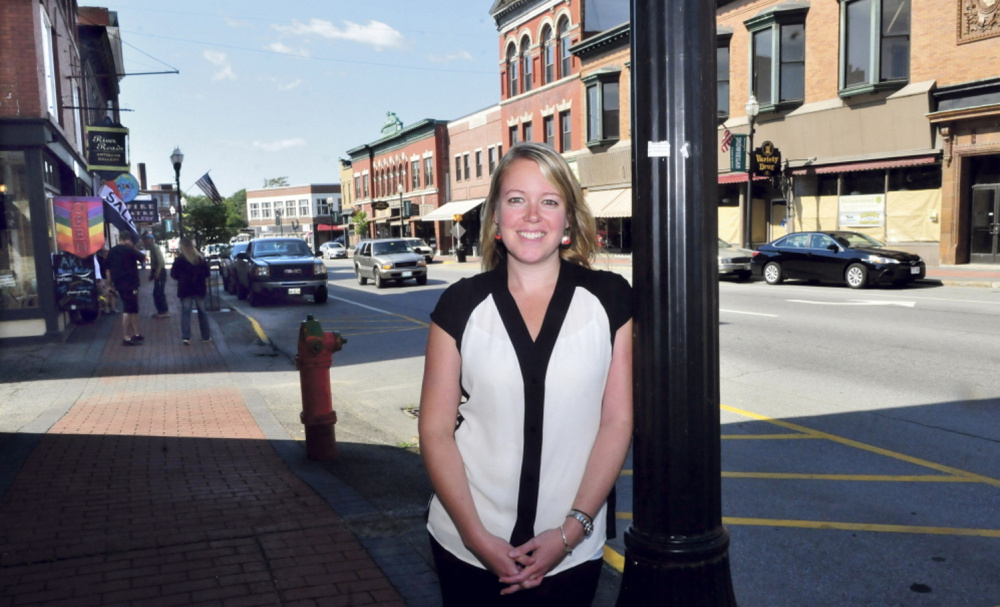SKOWHEGAN — Fresh from a weeklong visit to whitewater parks in Colorado and equipped with a recent $15,000 grant, Skowhegan town officials are more positive than ever that a proposed white-water park in the Kennebec Gorge downtown is the key to making Skowhegan a recreation destination.
Town Manager Christine Almand and Kristina Cannon, executive director of Main Street Skowhegan, traveled to five river recreation parks, starting in Golden, Colorado. They said the river activities, tied in with trails, hotels, breweries and restaurants, are just what they envision for Skowhegan’s Run of River project.
“A business owner in Salida (Colorado) told us that the revitalization in their town started the day they put the white-water feature in,” Cannon said Thursday. “There are all sorts of significant economic drivers that have sprung up as a result of this white-water park.”
Cannon said another business owner told them that his bar and restaurant went from $600,000 in sales before the white-water park to $4 million a year after the park opened.
In Skowhegan, after more than 10 years of planning, Run of River organizers released an economic impact study in October estimating the park could generate $6 million in revenue and 43 new local jobs in just the first year of operation in Somerset County with jobs in restaurants, hotels and businesses associated with paddling, canoeing and kayaking.
The project, with its man-made bumps and white-water rapids, also could produce as much as $19 million and as many as 136 local jobs in its 10th year of operation, according to the study.
The scope of the operation can be seen on the project’s website, www.runofriver.org. It also has a page on Facebook.
The objective of the $4.3 million Run of River is to create white-water waves in three locations to attract boaters for a park-and-play destination, waves for surfers and body boarders, and a half-mile run for rafting and kayaking, according to the model presented to selectmen in 2014 by McLaughlin Whitewater Design Group.
Cannon said the water park in its proposed model so far has three man-made features in the river — one just below the walking bridge, one in a rapid part-way down the river and a third at the edge of the Great Eddy of the Kennebec, where there is an existing surfing “pipe,” or series of waves.
An $80,000 U.S. Department of Agriculture rural business opportunity grant was used to complete engineering on a digital model of the park, a requirement for the many permits the park will need.
If approved, the project will have a slalom course and will improve physical and visual access to the gorge by creating four-season, nonmotorized trails down to the river and terraced seating along the shore. There still is no construction or completion date.
An unofficial trail committee, including Jason Cooke, formerly of Maine Huts & Trails, and Derek Ellis, manager of Lake George Region Park, envisions trails all the way to the Half Moon Bridge of U.S. Route 2 east of downtown.
“There have been additional things that we have added to the vision,” Cannon said. “We feel that in order to make the river a success, we have to have more than just the water park. The economic impact study cited spectators as the most important part of economic impact.”
Existing trails will be expanded and new trails are proposed through downtown from the Old Mill Pub to Coburn Park and all the way to the Kennebec Banks rest area on U.S. Route 2, owned by Somerset Woods Trustees.
Cannon said the project also includes a riverfront promenade, pristine fishing water with improved fish habitat, and a boathouse and events center.
The expanded Run of River Committee, with Skowhegan Road Commissioner Greg Dore as chairman, this month received a $15,000 grant from the Davis Conservation Foundation. The money will be used to cover costs of the permitting process. The committee will work with McLaughlin Whitewater and Kleinschmidt Associates engineers as well as with permitting agencies, including the U.S. Army Corps of Engineers, the U.S. Fish and Wildlife Service, the National Marine Fisheries Services, the Maine Department of Environmental Protection and the Maine Department of Inland Fisheries & Wildlife. Native American tribes also will weigh in on the project, as will Maine historic preservation groups.
The plan also includes removal of remaining debris from an old railroad bridge that was washed away in the flood of 1987 and restoration of some of the structure and character lost to clearing during the log driving era, which ended in 1974.
“I think any time you build a vision, as things come along, more and more people are going to grab on to it,” Almand said. “The more energy you have around something, the easier it’s going to be to win everyone’s hearts.”
Almand said a business plan has been assembled and the group continues to look for new sources of funding for the project. The town has contributed $1.4 million for the project through funds captured in the Sappi tax increment financing district.
Doug Harlow — 612-2367
Twitter:@Doug_Harlow
Send questions/comments to the editors.





